PROTECT YOUR DNA WITH QUANTUM TECHNOLOGY
Orgo-Life the new way to the future Advertising by AdpathwayHeirloom squashes stand the test of time, passed on for generations for their landscape performance, use, and flavor. With remnants discovered in cliff dwellings, squash is one of the oldest cultivated vegetables, used in ancient civilizations in the Southwestern U.S. and Mexico at least 8000 years ago. Our heirlooms today have strains in the ancestral species with integral qualities that evolve over time to adapt to geographical conditions.
“Heirloom” can mean different things when it comes to historic crops, often referring to those introduced before 1951 when the first hybrids became commercially available. They represent our heritage crops, foodways, and selections preserved for exceptional flavor and growing qualities.
Heirloom squash varieties not only bring the best in flavor, they’re also ornamental in seasonal displays, where we can appreciate the harvest. Sow the beauties in early summer to allow them time to mature. For short growing seasons or late plantings, opt for quick-maturing vines that are compact and productive.
Lakota Winter Squash

Lakota Winter Squash Seeds
Black Beauty Summer Squash

Black Beauty Summer Squash Seeds
Cinderella Pumpkin

‘Tromboncino’
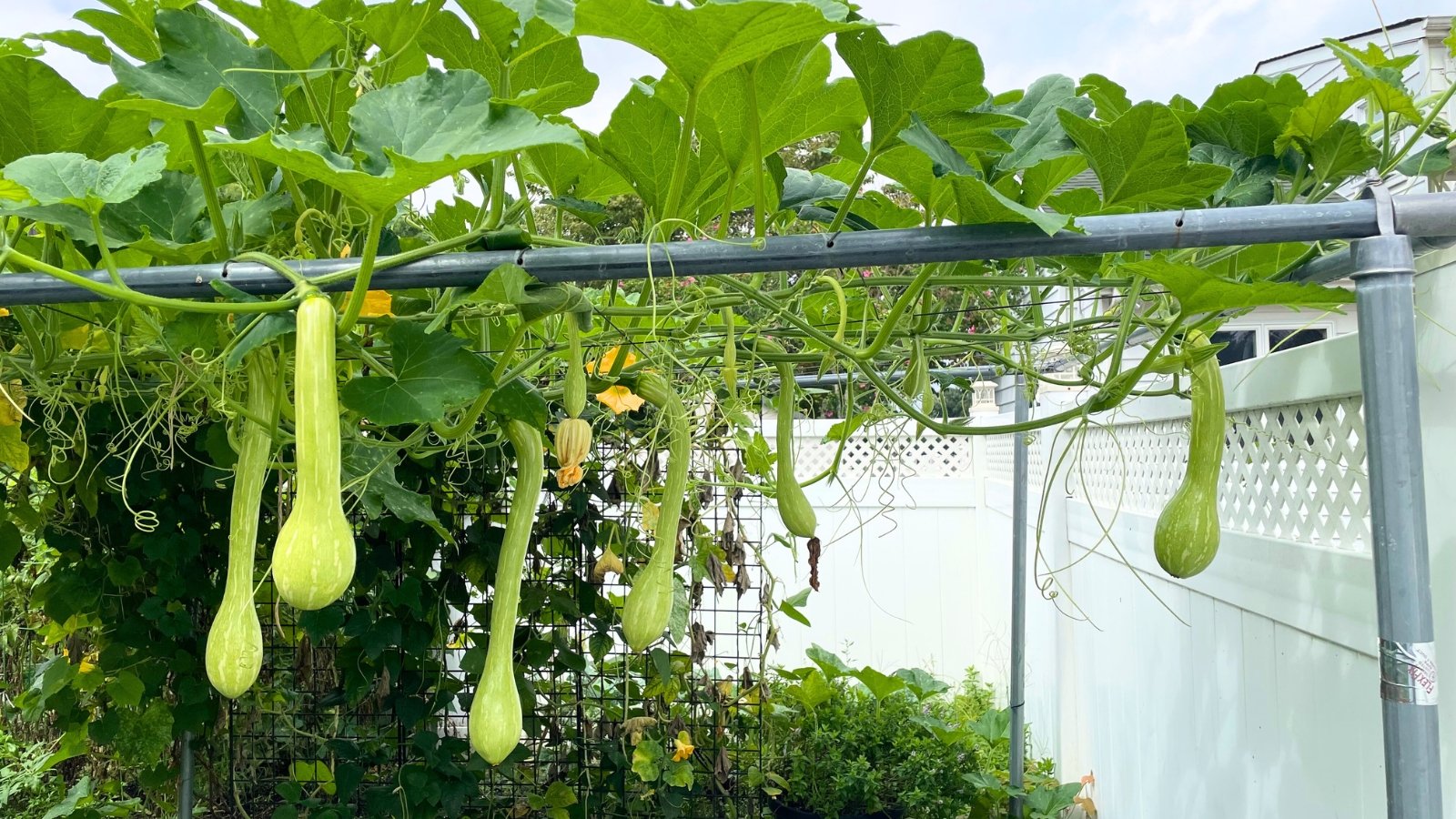 Curved fruits hang like garden ornaments on climbing vines.
Curved fruits hang like garden ornaments on climbing vines.‘Tromboncino,’ also called ‘Zucchino Rampicante,’ is a spectacle on the vine. The long, curved fruits of the Italian heirloom develop in late summer, but are delicious, too, when harvested young and green. As young winter squashes, they provide a flavorful stand-in for zucchini. They tan and develop their butternut characteristics in the fall.
‘Tromboncino’ has vigorous vines that take well to growing vertically on a trellis or arch. Watch the show unfold as the fruits develop (they can reach up to three feet on the vine).
C. moschata is more resistant to squash vine borer infestations than other species. Their thick, smooth stems make them less accessible during egg-laying and larval cycles
‘Honeynut’
 It stays tidy, climbs well, and keeps on producing beautifully.
It stays tidy, climbs well, and keeps on producing beautifully.‘Honeynut’ is another moschata selection with good squash vine borer and powdery mildew resistance. The hybrid from Cornell’s breeding program crosses butternut and buttercup varieties for a superior sweet taste and smooth texture.
The little butternuts are four to five inches long. They start mottled green and ripen to soft orange-red. They store for up to six months.
‘Honeynut’ has short, bushy vines that make the compact heirloom squash variety perfect for vertical situations and small spaces. Growing squash on upright supports offers a number of benefits, including improving air circulation and staving off fungal diseases, uniform fruit production, and saving space.
‘Green-Striped Cushaw’
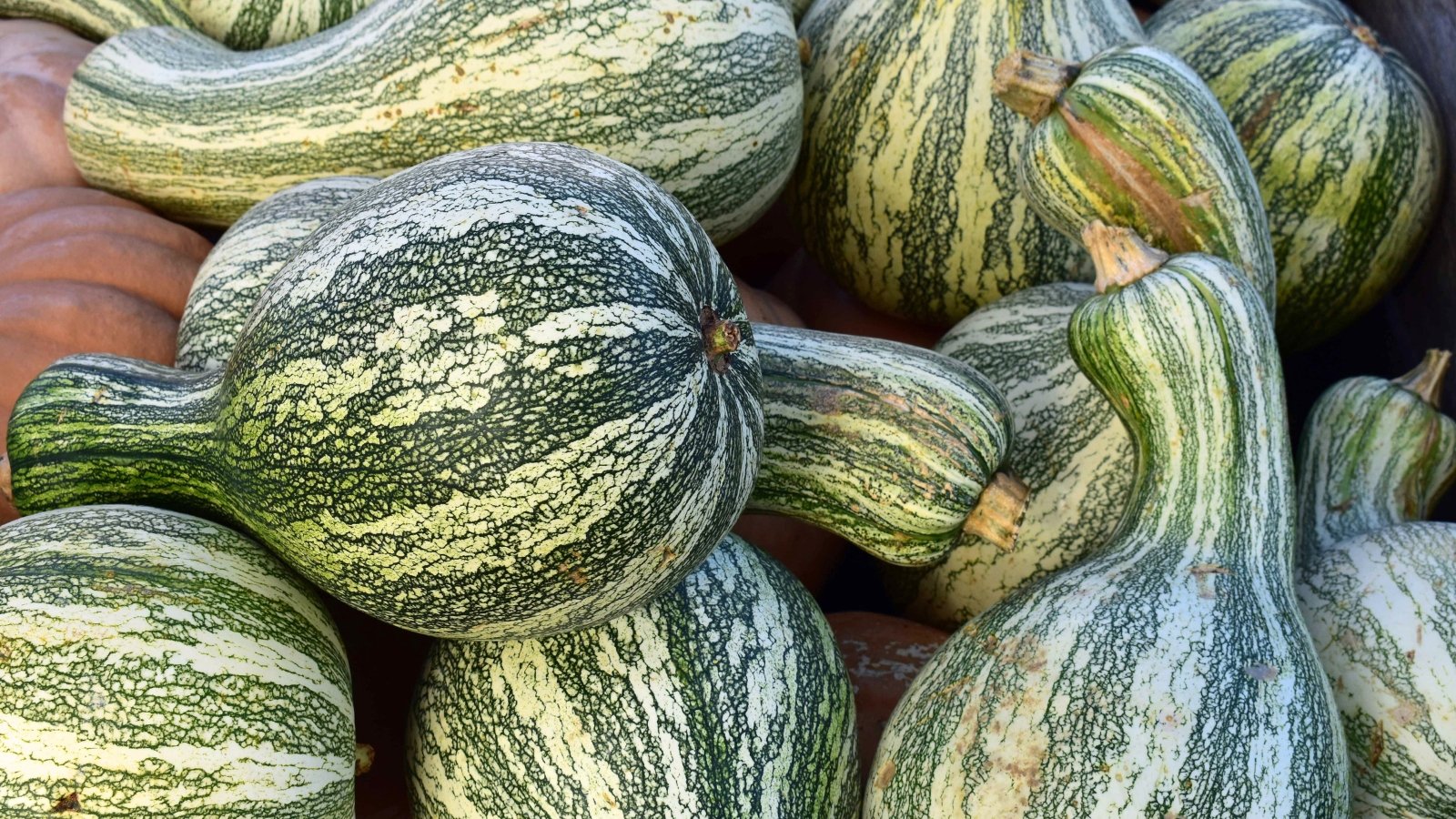 Large and lovely, they are best enjoyed right after harvest time.
Large and lovely, they are best enjoyed right after harvest time.‘Green Striped Cushaw’ is a striped crook-necked squash with white, mottled skin in light and dark green. Showy and delicious, the vigorous vines produce reliably and resist key cucurbit pests, including squash vine borer.
‘Green Striped Cushaw’ is mildly sweet, with a medium-textured, light colored flesh. The sizeable fruits reach 18 inches long and 10 inches wide at the base. With tender skins, these have a shorter storage life than others; enjoy them close to picking time.
‘Seminole’
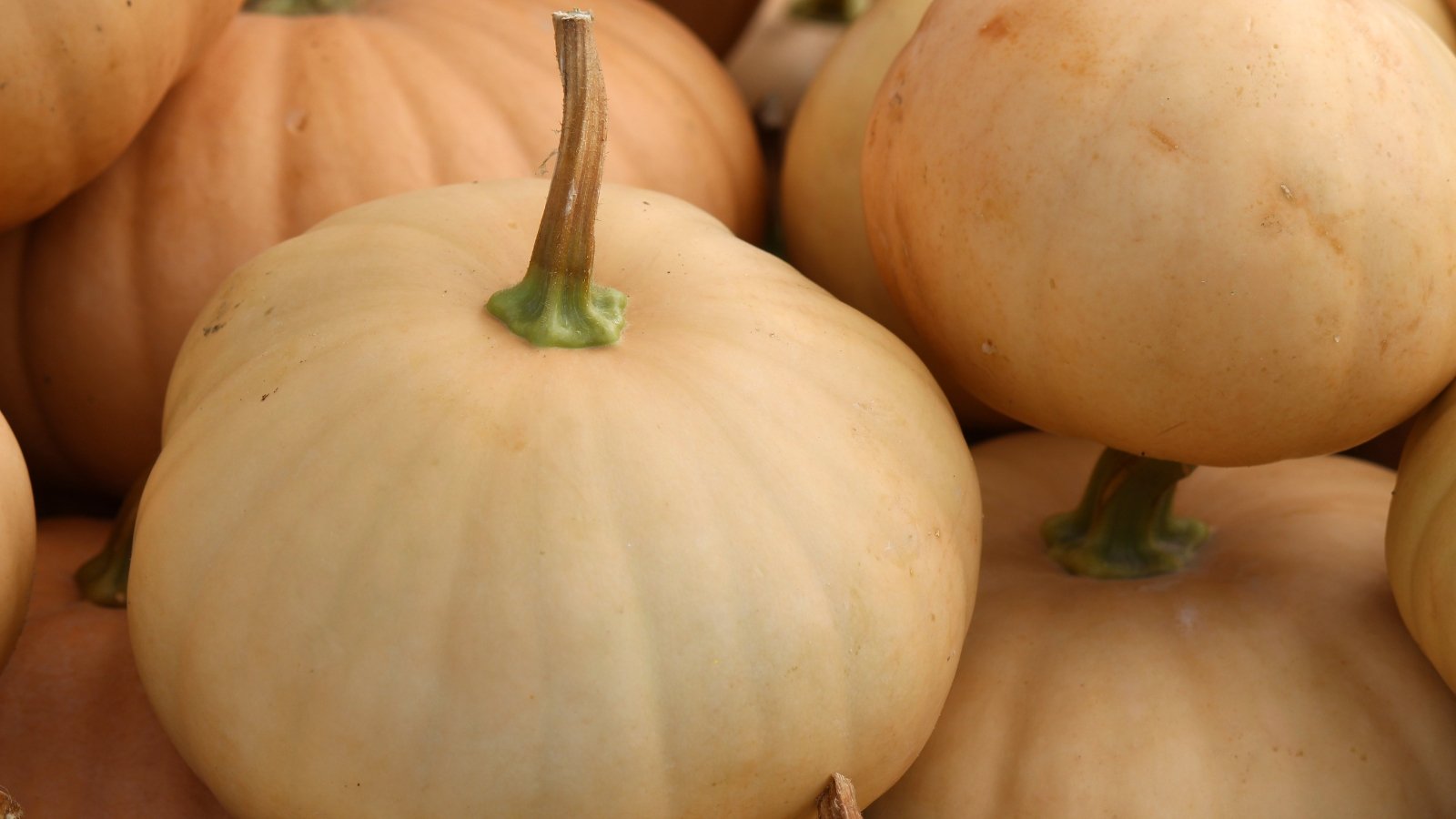 It grows strong in heat with vines full of orange treasures.
It grows strong in heat with vines full of orange treasures.Seminole pumpkins are native to Florida and are a testament to growing in hot, humid climates.. Tribes including the Seminole, Creek, Miccosukee, Muscogee, and Calusa cultivated the resilient winter squashes with long, leafy, sprawling vines.
‘Seminole’ produces six-inch bell-shaped fruits with firm skin and deep orange flesh. The flavor is sweeter than other butternuts and a good stand-in for classic pumpkins. Harvest in early fall at full size, or pick them early and tender as summer squash.
The moschata selection boasts excellent mildew resistance and tough stems to defend against moths and caterpillars (including squash vine borer). The mature pumpkins weigh six to twelve pounds.
‘Lakota’
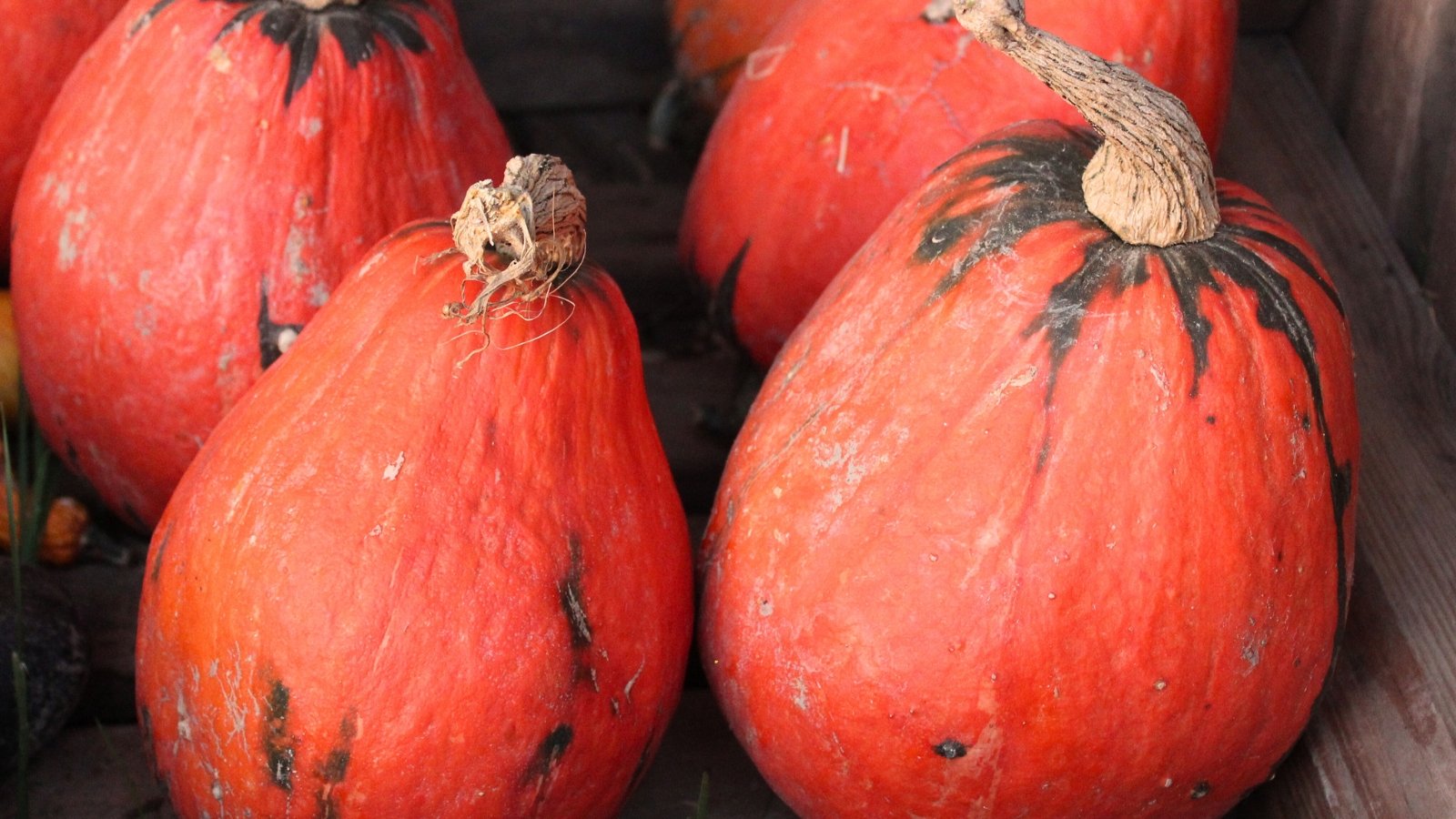 Pear-shaped squash stands out in any garden patch.
Pear-shaped squash stands out in any garden patch.‘Lakota’ is both eye-catching and delicious. The unique variety has deep crimson-orange skin with variations in green mottling, as though dipped in green paint. The pear-shaped fruits weigh between four and eight pounds.
‘Lakota’ is a baking type heirloom squash variety with smooth, sweet, and nutty orange flesh. It grows across various conditions with ease until fall’s first frost. For an extra treat, roast the seeds for a healthy snack.
‘Lakota’ comes from a century of hybridization. It began with an unnamed variety that cross-pollinated in personal gardens as growers shared seeds. Later, it crossed with a ‘Hubbard’ squash. The University of Nebraska made it genetically stable for the ‘Lakota’ strain we grow today.
‘Red Kuri’
 They’re ready to harvest in just about ninety-five days.
They’re ready to harvest in just about ninety-five days.‘Red Kuri’ is a delicacy with a creamy texture and chestnut flavor (kuri means “chestnut” in Japanese). Melon-orange and sweet like pumpkins (some say better), they’re ideal for steaming, roasting, and baking.
With compact vines and fruits, this heirloom squash variety is a fit for small gardens, containers, and easy trellising. Each plant yields two to five teardrop fruits that weigh three to four pounds.
‘Red Kuri’ is a good selection for gardeners with short growing seasons, and it develops relatively quickly for winter squash. ‘Red Kuri’ is ready to harvest in about 95 days.
‘Pink Banana’
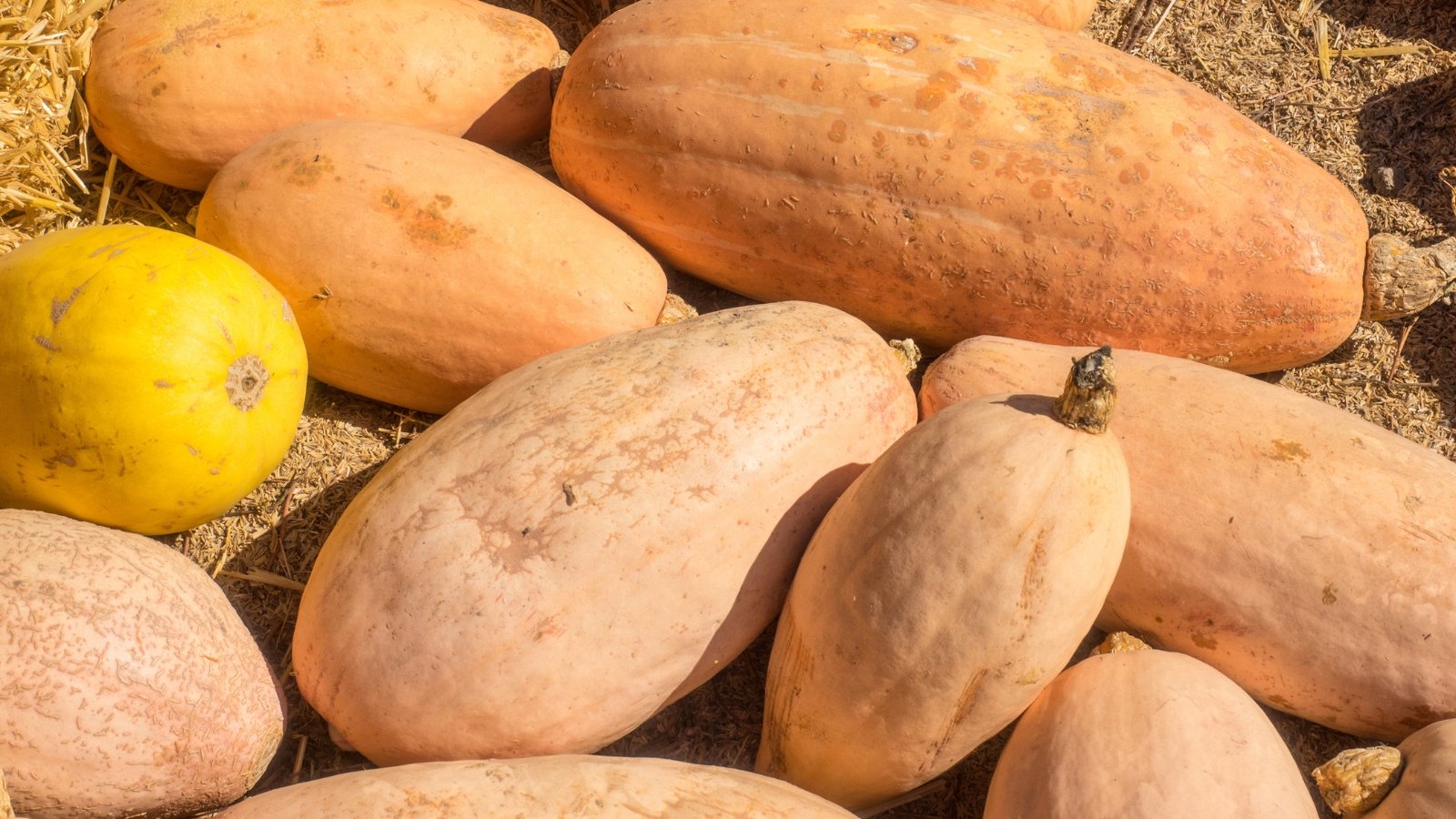 It’s a tasty conversation starter on the autumn table.
It’s a tasty conversation starter on the autumn table.‘Pink Banana’ is a conversation piece in the autumnal display and delicious in pies, baked dishes, and on its own. The large, salmon-pink squashes measure up to two feet long. In the dish,
Sugary and tender, each ‘Pink Banana’ weighs 10 to 12 pounds and has a bright golden-orange interior. A narrow seed cavity offers more room for the meaty flesh.
‘Pink Banana’ has native origins in Argentina and Uruguay, where ancient cultures utilized the banana squash, as did American pioneers. ‘Pink Banana’ brings a historic staple to the edible landscape and table.
‘Vegetable Spaghetti’
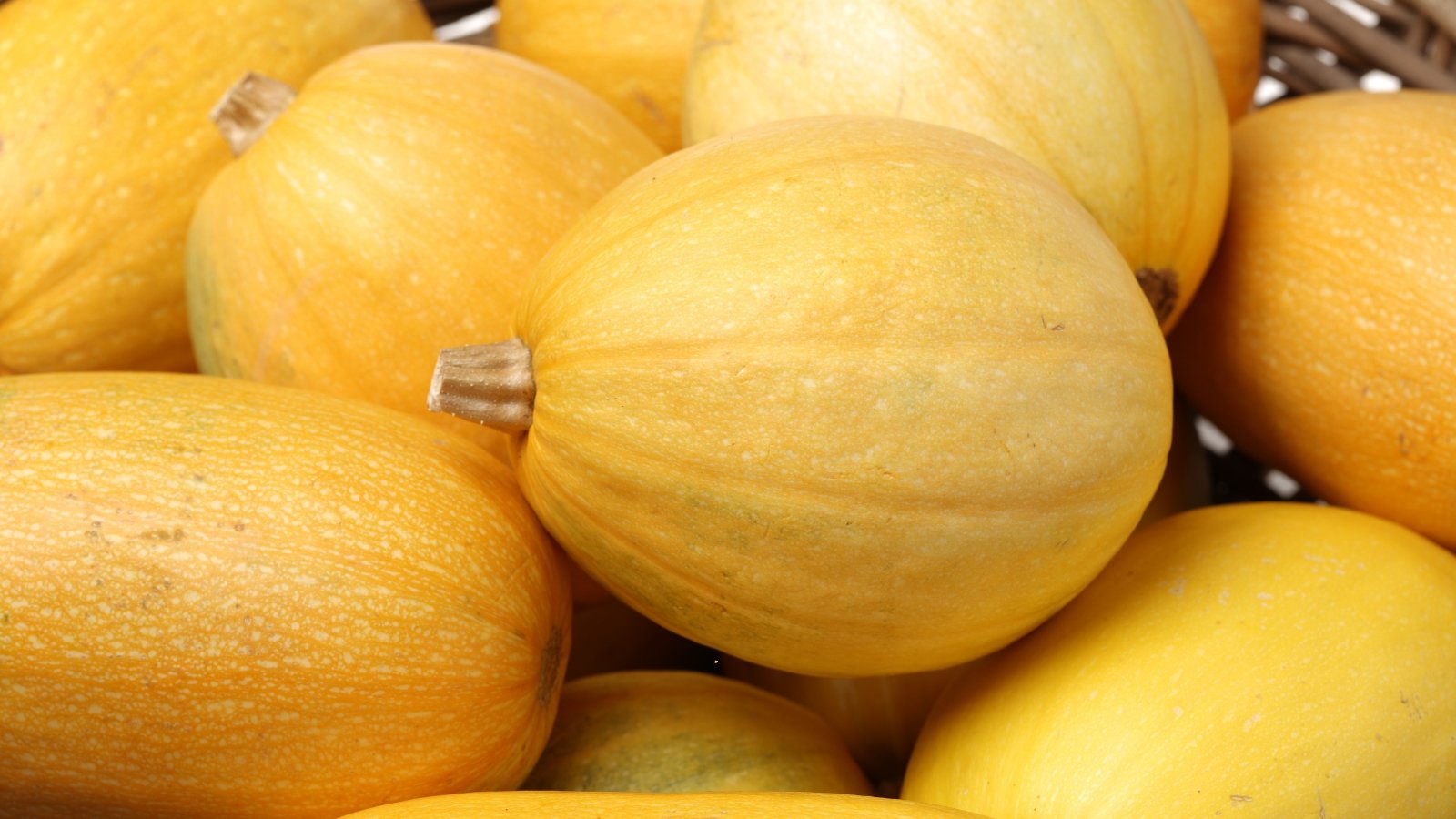 It’s delicious on its own with just butter or oil.
It’s delicious on its own with just butter or oil.‘Spaghetti’ is native to the U.S. and Mexico. Also called gold string melon, its stringy interior is a nutritious stand-in for pasta.
With baking or boiling, the flesh separates easily into thin, narrow pieces for a nest of healthy “spaghetti” with a neutral flavor to pair with sauces, cheeses, and other vegetables. It also stands alone and is tasty with butter or oil.
Rinds and interiors of spaghetti squash are pale yellow, and each fruit reaches 8 to 12 inches long.
‘Galeux d’Eysines’
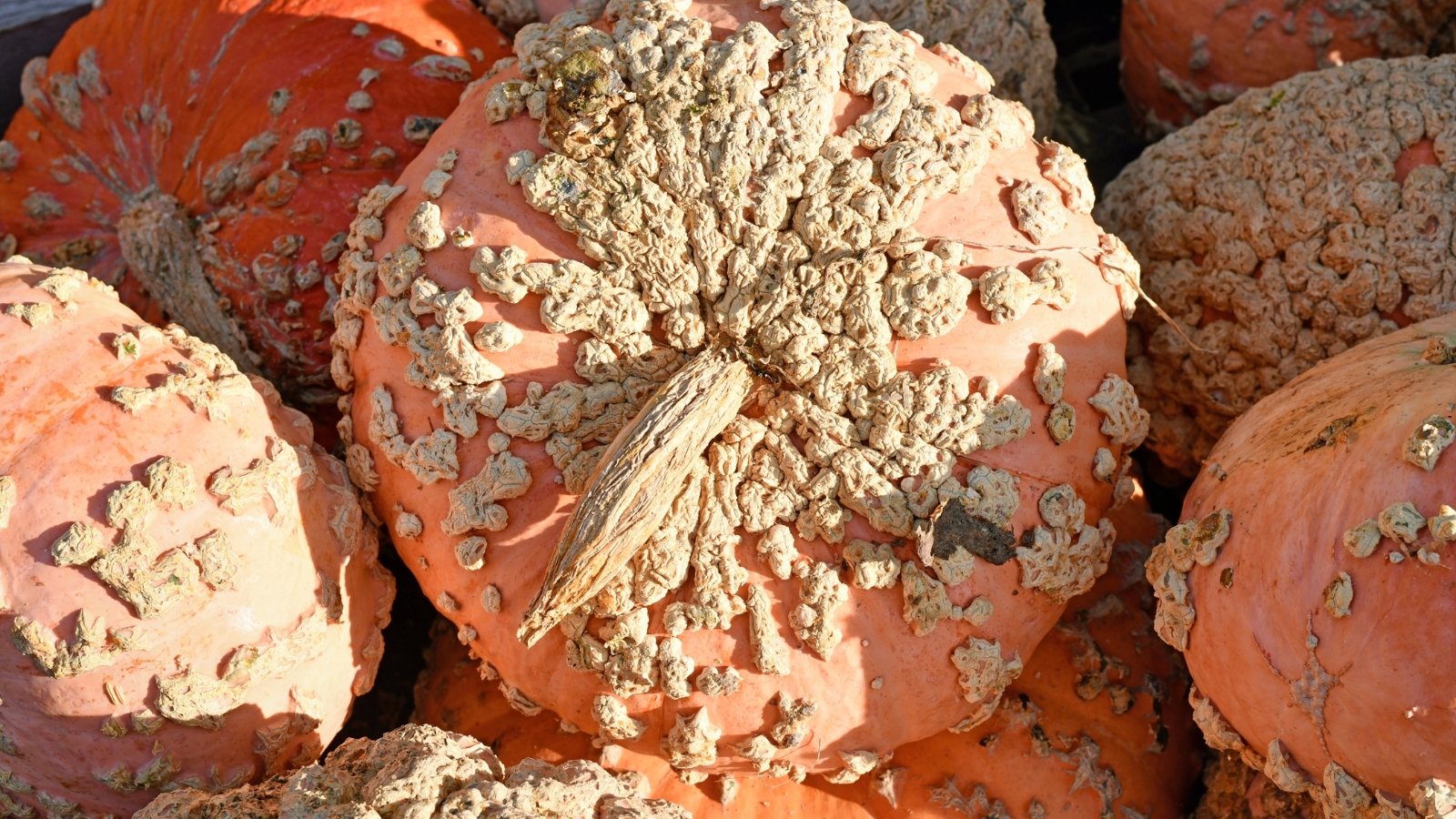 It stores well for months, staying tasty and fresh.
It stores well for months, staying tasty and fresh.‘Galeux d’Eysines’ is a uniquely beautiful and bumpy pumpkin with a high sugar content. In buff peach, the pastel gourds have warty outer skins caused by crystallized sugars beneath. A bumpy pumpkin is a sign of a sweet interior and high sugar content.
‘Galeux’ has the nickname “peanut” pumpkin because of its rough exterior, though the orange interior is smooth. Each hefty pumpkin may reach one foot in diameter and weigh 10 to 15 pounds.
The French heirloom is versatile in cuisine, including soups and sauces. They store for up to six months and make a showpiece in harvest displays.
‘Table Queen’
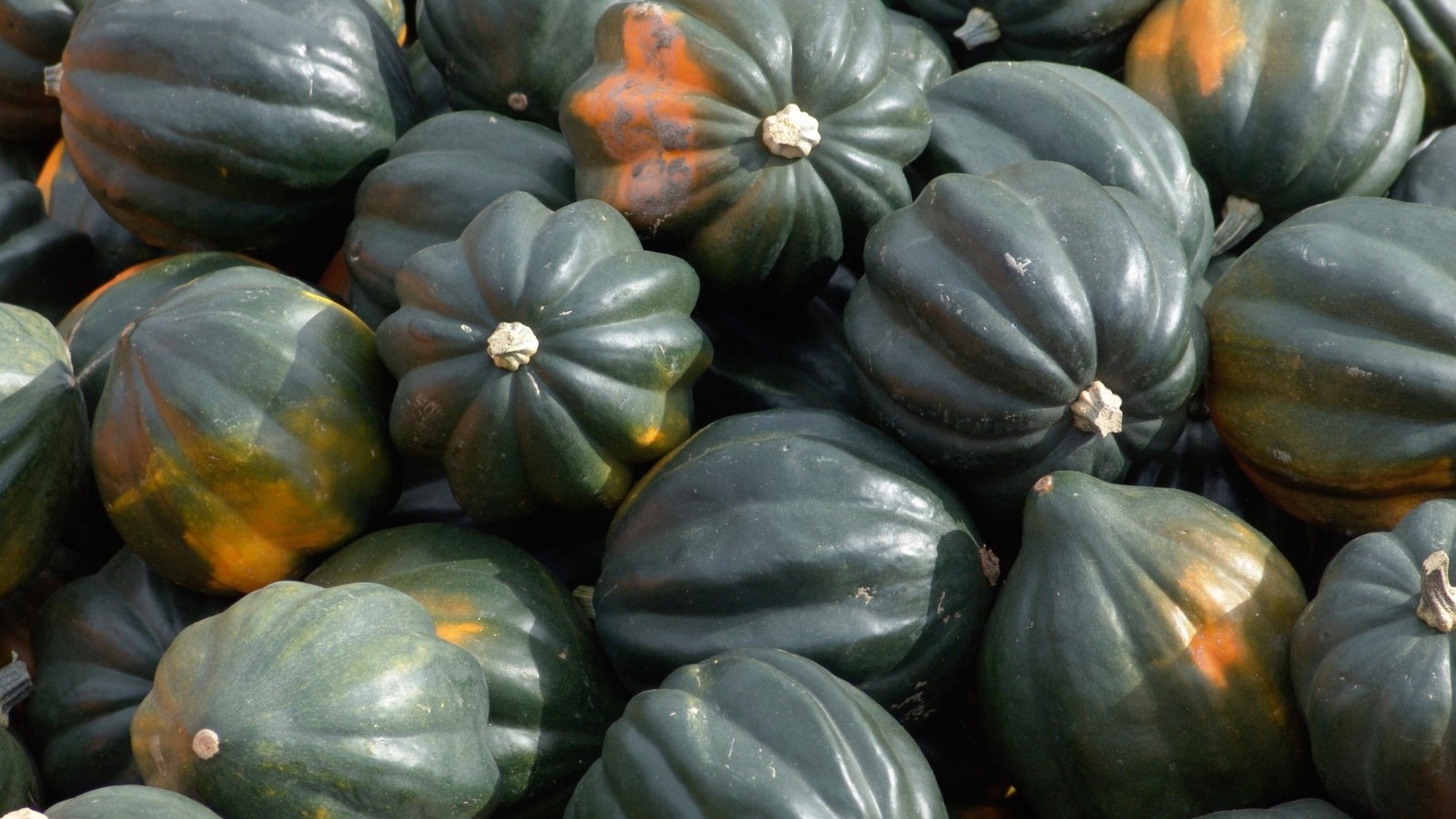 This is a classic choice for early fall garden harvests.
This is a classic choice for early fall garden harvests.‘Table Queen’ is a historical acorn type that sets the standard for small, individual-sized fall squashes. The Iowa Seed Company out of Des Moines introduced ‘Table Queen’ in 1913.
With a sugary interior, the petite acorns are perfect for baking. The shiny, dark green one-pound rounds have a high-quality yellow-orange flesh.
For an early maturing, compact variety, look to ‘Table King.’ The All-America Selections winter from the University of Connecticut in 1974 matures in 80 days on compact, four-foot forms.
‘Delicata’
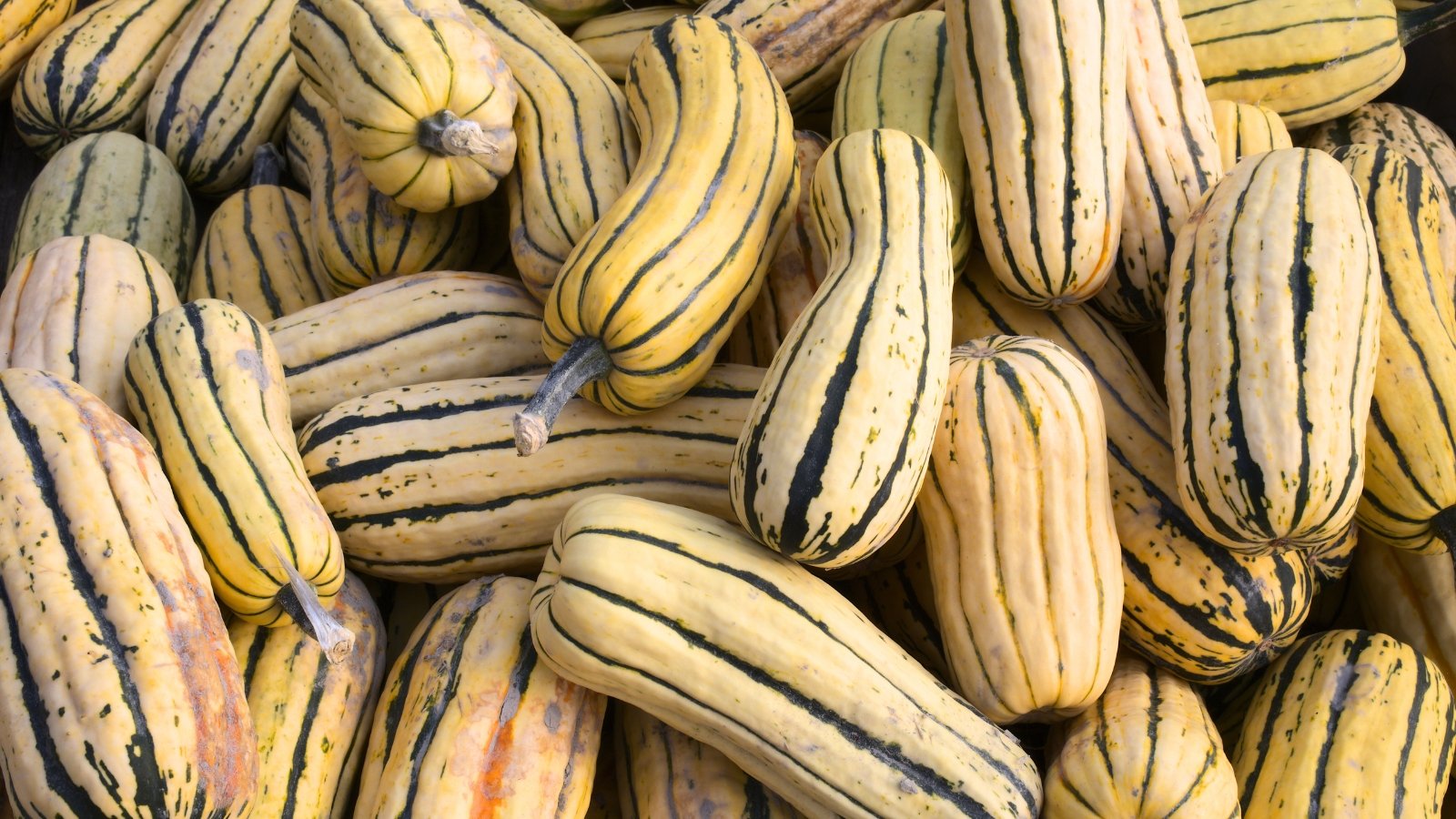 They’re ready to eat right from the garden vine.
They’re ready to eat right from the garden vine.‘Delicata’ is a prize as one of the sweetest squashes around. This heirloom from 1894 has a high sugar content and fine-textured, golden interiors. Fruits are sweet right off the vine with a thin skin for easy preparation. There’s no need for peeling; the skin is edible with a nutty taste.
‘Delicata’ is an elongated fruit, creamy-white with orange tones and dark green stripes and flecks. Each grows about eight inches long and four inches wide, weighing in at one to three pounds. Storage time is only a few months, best enjoyed in fall or frozen for warming up winter evenings.
‘Rouge Vif d’Étampes’
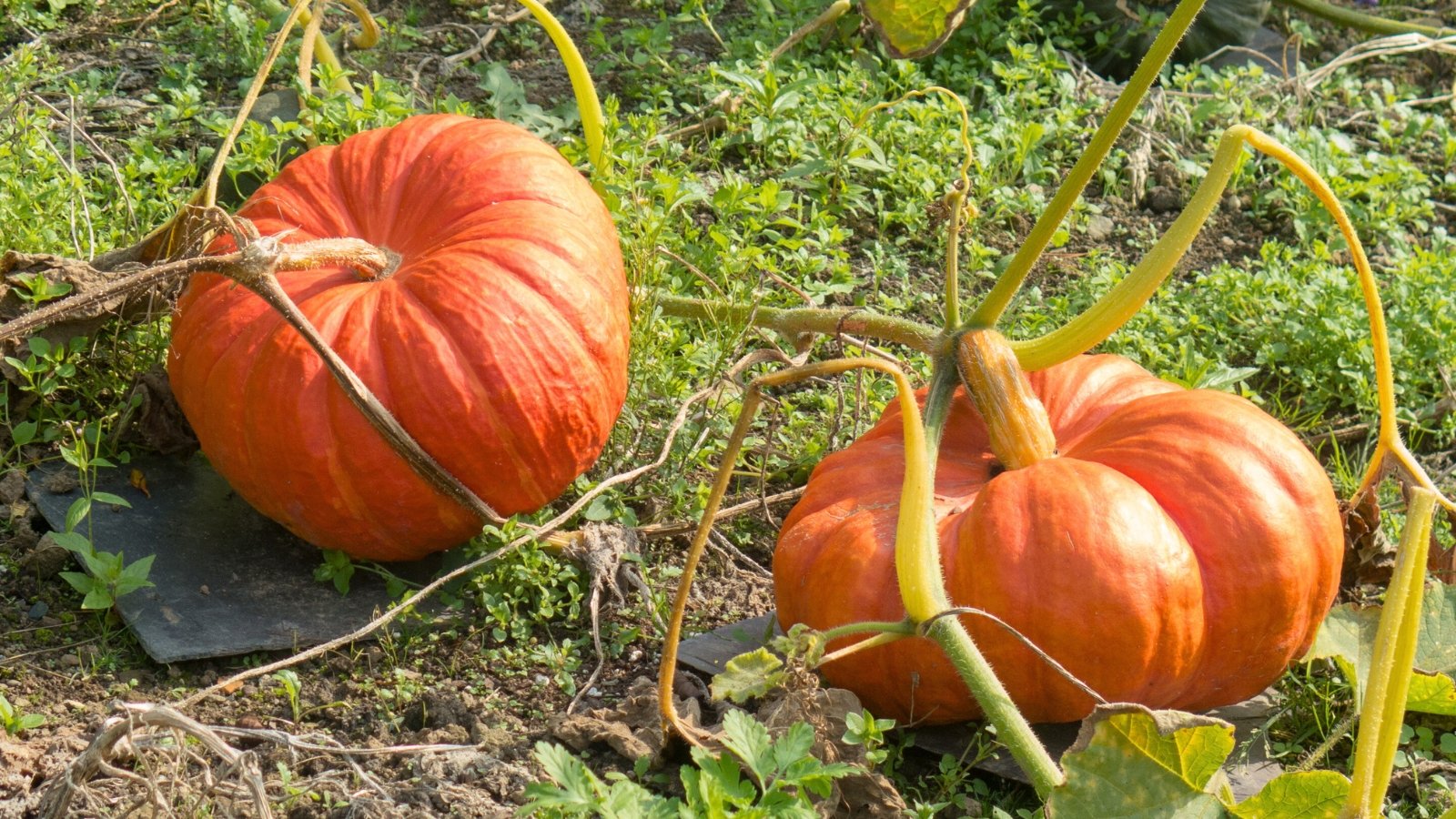 These beautifully shaped pumpkins last well through winter.
These beautifully shaped pumpkins last well through winter.‘Rouge Vif d’Étampes’ is the famous ‘Cinderella’ carriage pumpkin with beautiful melon-orange rounds. The favorite is from 1880s Paris, and a classic of the season with a long shelf life.
The large fruits are slightly squat with deep ribs. They reach one to two feet around and may weigh 15 to 20 pounds each.
‘Rouge’ has a mild, slightly sweet flavor, best for baking and canning. It’s also a highlight of autumnal displays.
‘Black Beauty’
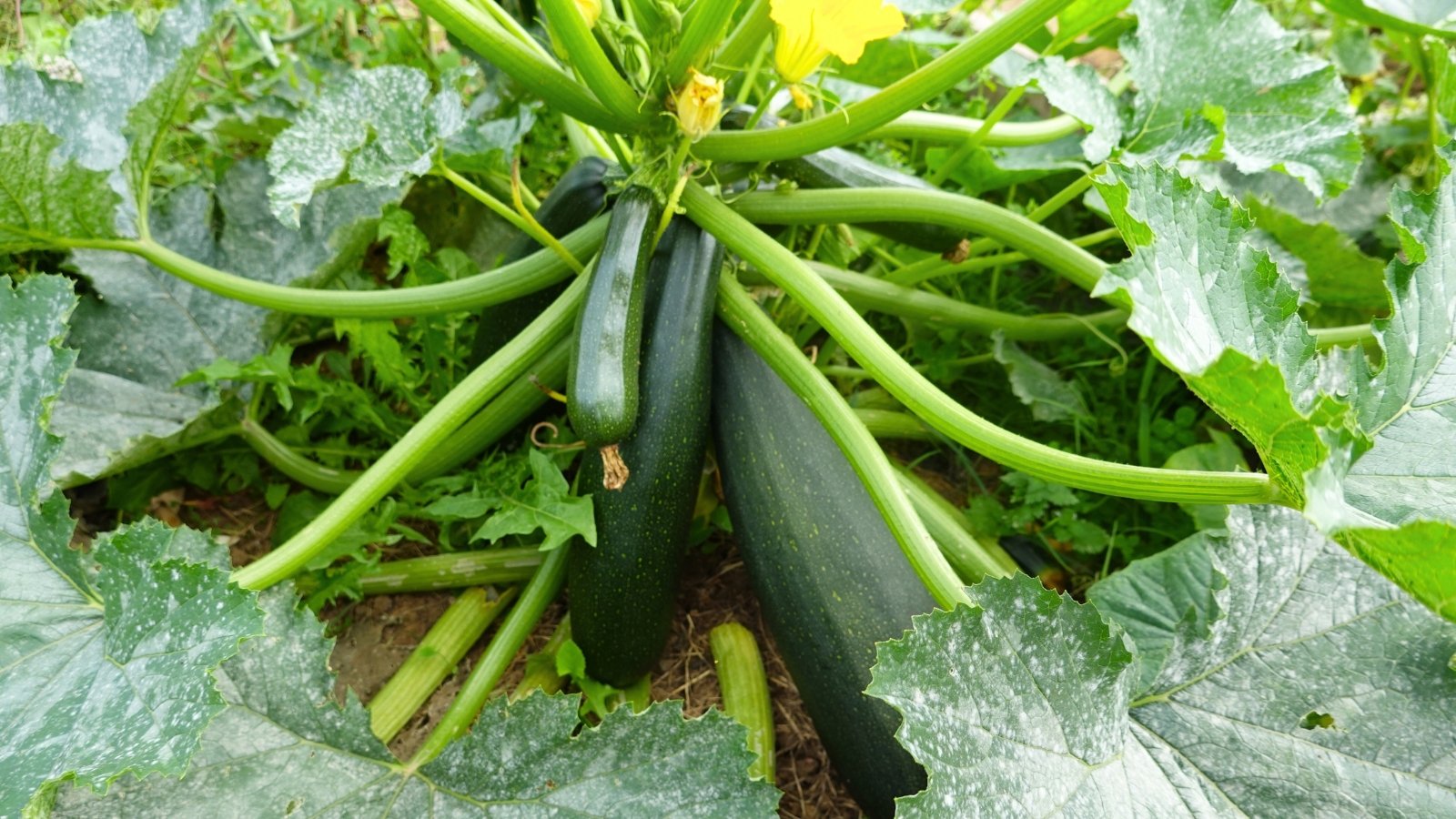 Compact vines produce early zucchinis with delicate skins.
Compact vines produce early zucchinis with delicate skins.‘Black Beauty’ rounds out our list as a favorite summer squash. The zucchini is a 1920s introduction and an All-America Selections winner. It offers a high yield of dark, greenish-black fruits that have thin skins and tender, creamy interiors.
This early-producing heirloom squash variety is easy to grow thanks to its compact, dense form. They grow quickly, with a harvest in 50 to 55 days after sowing. Pick ‘Black Beauty’ as young fruits to enjoy the best texture and flavor.


 1 week ago
12
1 week ago
12





















 English (US) ·
English (US) ·  French (CA) ·
French (CA) ·